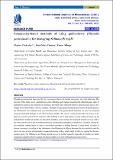Community-based methods of using goldenberry (Physalis peruviana L.) for managing Salmonella typhi

View/
Date
2022-08Author
Chekecha, Charles
Vianney, John-Mar
Mbega, Ernest
Metadata
Show full item recordAbstract
Physalis peruviana has been used for the treatment of bacterial, fungal, protozoan, and viral infections. The purpose of this study was to establish knowledge, attitudes, and practices regarding the ethnobotanical value of goldenberry plants in the treatment of infections. The study was conducted between April and June 2021 in five villages in the Mbeya Rural District, Tanzania. Through focused group discussion and structured questionnaires, the information was collected from 15 traditional healers and 93 household members. All data was analyzed using the Statistical Package for the Social Sciences (SPSS). The overall survey revealed that the leaves of the plant are used for typhoid fever treatment. The methods for plant preparation include boiling of leaves (33.3% and 29.8% for traditional healers and household members, respectively) and soaking of ground leaves in cold or hot water (66.7% and 70.2% for traditional healers and household members, respectively). Therefore, among the two methods, soaking leaves in water is preferable compared to boiling because it works better in terms of disease treatment. According to key informants, the differences in efficacy between the two methods could be due to the loss of some phytochemical compounds during boiling, which might be effective against the disease-causing agent. The differences in efficacy provide access for further research, especially in finding out which compounds might be effective against the disease might be present in Physalis peruviana leaves.
URI
http://dx.doi.org/10.12692/ijb/21.2.340-351https://dspace.nm-aist.ac.tz/handle/20.500.12479/2416
